 The 2019 NACS Convenience Summit Asia, held in Shanghai, China, on March 5-7 condensed the key learning and insights from one of the world’s fastest growing convenience markets. The three-day event, supported by the NACS Global Supplier Council, had a bit of everything: an overview of the Chinese market and convenience retail in China, including highlights and examples of new types of retail concepts, plus topical themes including next-generation payments and vehicles and fuels.
The 2019 NACS Convenience Summit Asia, held in Shanghai, China, on March 5-7 condensed the key learning and insights from one of the world’s fastest growing convenience markets. The three-day event, supported by the NACS Global Supplier Council, had a bit of everything: an overview of the Chinese market and convenience retail in China, including highlights and examples of new types of retail concepts, plus topical themes including next-generation payments and vehicles and fuels.
Retailer case studies featured both indigenous and overseas competitors from the convenience and forecourt arena. The event commenced with a walking store tour in Shanghai, taking in an eclectic mix of retailers and specialist operators.
Retailers are using technologies to solve a problem versus technologies looking for a problem to solve.
Convenience in China
Henry Armour, NACS president and CEO, set the scene for the Summit when he stated, “The future is here…it’s just unevenly distributed.” By examining the future taking place in China, NACS Convenience Summit Asia explored how the nation compares with the rest of the world on certain global issue lifecycles. China is on the forefront of many trends including payments systems, digital marketing, emerging technologies, foodservice in small spaces, supply chain logistics, delivery and EVs. “Retailers are using technologies to solve a problem versus technologies looking for a problem to solve,” Armour said.
Brady Ni from Nielsen China provided an overview on Chinese consumers and the retail channels they like to shop. Chinese consumers require instant satisfaction and faster delivery speed, he shared. The e-commerce evolution has created a diversified retail commerce landscape in China, however, with C2C, B2C and now merged online and offline models billed as “new retail.” Short-distance logistics are also very evident, driven by the high population densities.
Ni advised retailers to keep an online-to-offline service to attract traffic and enhance efficiency of fulfilling orders. He urged retailers to create a diverse experience, by upgrading their physical stores with digital solutions and being aware of the unmanned store—even though it’s yet to deliver the best shopper experience. Retailers should also explore the empowerment of grocery by leveraging supply chain sourcing to reach a wider and deeper geography, Ni advised.
 Attendees learned a bit of everything during the three-day event, including an overview of the Chinese market and convenience retail in China, as well as retailer case studies.
Attendees learned a bit of everything during the three-day event, including an overview of the Chinese market and convenience retail in China, as well as retailer case studies.
The scale of the convenience market in China—the world’s second largest economy—was also put under the spotlight at the Summit. There are now more than 100,000 convenience stores in China, with combined annual revenue of 190 billion yuan ($28.3 billion). First- and second-tier cities are still popular locations for new store openings. Regional players have taken the lead in the small-format retail sector, but no single operator has yet established a national presence, excluding stores linked with gas stations.
Single-day sales per store averaged about 5,000 yuan in 2017 (or about $745). The convenience store sector grew 23% year-on-year in 2017 in terms of same-store sales and new openings, down from 31% in 2016. New momentum coming from internet giants’ involvement has intensified competition and altered the layout of the sector. More than half of stores offer mobile payment options via Tencent Holdings’ WeChat app, slightly higher than the number offering Alibaba Group Holding’s Alipay. Companies have poured investment into new technology, with a focus on self-pay stores and updating logistics.
So far, 36% of convenience retailers have adopted online operations. Those companies said online sales contributed 10% of their total revenue. About 40% of the companies have set up a membership system to offer promotional deals. The membership business model is still in its infancy in the Chinese sector, contributing 35% of sales. Despite the sector’s rapid expansion, convenience stores are facing bottlenecks, largely in the rising cost of rent (up by 18% year-on-year), labor (up 12%) and utility bills (up 6.9%).
Shanghai Store Tours
A walking store tour around Shanghai gave Convenience Summit Asia attendees a first-hand look at new retail design and next-generation technologies. The tour featured a broad range of retailers and sector specialists.
- City’super: aimed at the top 5% of income earners in Shanghai and specializing in upscale imported grocery products, with seasonal displays at the entrance and around the store.
- Hey Tea: a Chinese teashop chain.
- �Blue Tree Coffee: aimed at the health and environmentally conscious consumer.
- Little B Convenience Store: a high-end convenience store located in an alleyway in Shanghai’s historic Xintiandi district, which takes inspiration from the aesthetic of pop-up shops.
According to NACS President and CEO Henry Armour, these operators are selling experiences and feelings versus products. Elsewhere, Family Mart, Lawson and Carrefour demonstrated crisp and excellent merchandising and put an international stamp on proceedings in China’s largest city.
Retailers with a singular category focus featured on the tour included:
- 1st Tree: a nutraceutical herbal store and restaurant, which brings ancient Chinese traditions to enhance one’s overall wellbeing and promote longevity.
- Gogo Fruitage: a high-end fruit store that sells a large variety of fresh and mostly imported fruit.
For delegates in need of a caffeine boost, coffee was plentiful:
- Pacific Coffee: a European-style coffee house that also sells its own brand of coffee beans and Jura Coffee machines and provides catering and delivery services.
- Ratio Care: a fully automated coffee shop run by robots or so-called cobots (collaborative robots), which help to create completely customized coffee drinks. Customers can order their morning cup exactly the way they want it via mobile and have it prepared to perfection by a cobot. The café turns out about 400 drinks a day, taking on average two minutes from order to table. The menu consists of more than 50 fixed coffee and cocktail drinks, as well as the option to create your own using preferred flavor profiles. All ordering is done through WeChat, the most popular messaging, social media and mobile payment app in China. Using artificial intelligence, Ratio has taken it a step further by storing customers’ orders and learning about their preferences to make recommendations for future visits.
New Retail
The trend to “new retail” was dissected by Matthew Brennan from China Channel, a China-focused tech consultancy and research firm. Online’s move to offline is being driven by the competitiveness and maturity of the online sector and the opportunity to grow offline. Brennan dubbed Hema, Alibaba’s superstore chain, as the “poster child” of new retail since it provides an experience center for entertainment and having fun with a goal to drive offline shoppers to shop online. “The essence behind new retail is to apply the idea and technology of the internet to restructure people, products and place in an all-around way from the place of origin to the hands of consumers,” said Brennan.
Data is like oil…it lubricates retail.
EasyGo, another “new retail” player on China’s convenience block, showcased its smart retail platforms, including autonomous retail stores, facial recognition for supermarkets and smart boxes such as the wecafé, a full-featured coffee robot.
Next-generation Payments
Next-generation payments was one of two key themes addressed at the Summit. China is already a leader in mobile payments, but delegates were keen to learn what is next on the payments horizon.
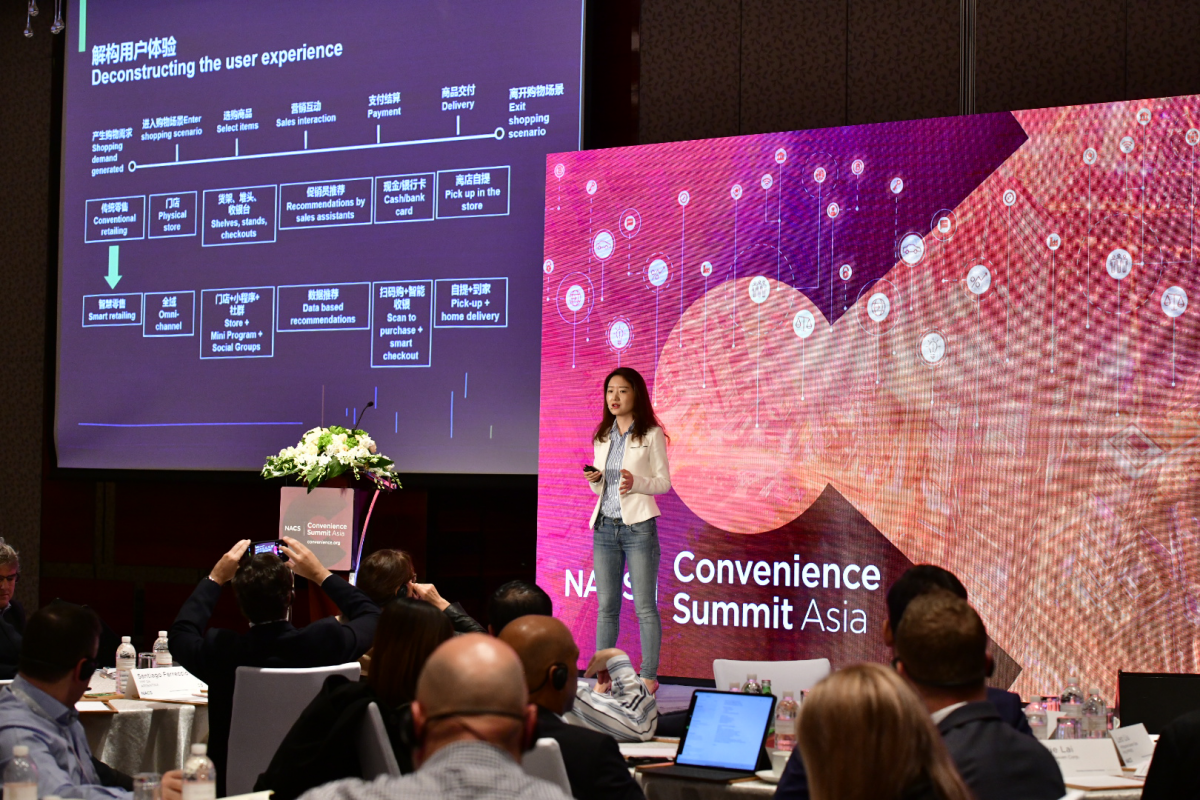 Kelly Wang, senior operation manager, WeChat Pay, showed how WeChat Pay powers smart retailing by digitizing the entire process for people, product and stores.
Kelly Wang, senior operation manager, WeChat Pay, showed how WeChat Pay powers smart retailing by digitizing the entire process for people, product and stores.
Kelly Wang, senior operation manager, WeChat payment department, showed how WeChat Pay powered smart retailing by digitizing the entire process for people, product and stores. Retailers can use payment traffic to increase connectivity via dynamic couponing or social media proliferation, for example. They can use payment data to empower operations—WeChat shares big data with retailers to create precision marketing. WeChat Pay also enhances the customer experience with faster payments, scan and go self-checkout and home delivery, for instance. Mini programs using the WeChat platform also help eliminate the need for apps.
“Smart retailing is not about a single digital upgrade to the retailing sector, but rather about being a leading internet-enabled industry,” Wang said.
Vehicles and Fuels
Vehicles and fuels also dominated conversation at the Summit. Klaas Mantel, head of global convenience retail, Shell, presented the customer insights and scenarios driving change within mobility retail.
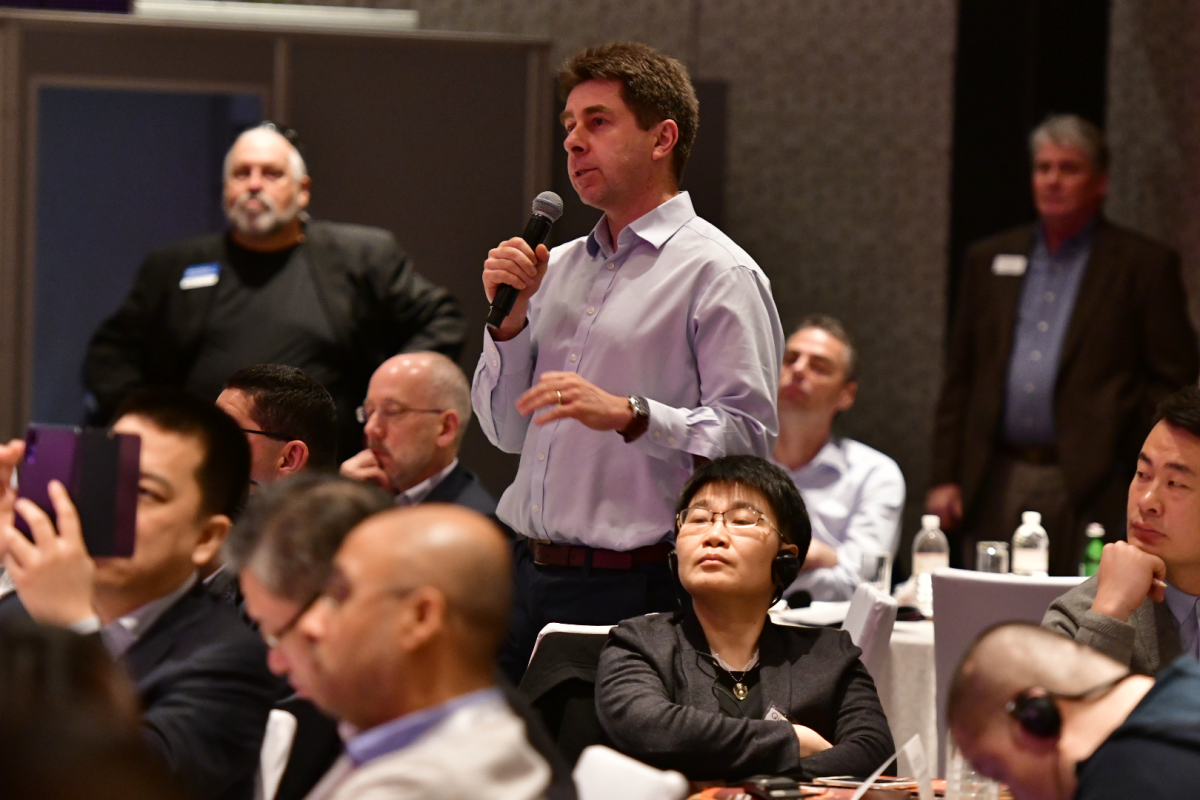 Attendees heard a number of retailer case studies, including Hema which is integrating online and offline channels.
Attendees heard a number of retailer case studies, including Hema which is integrating online and offline channels.
The way people “consume mobility” will undergo fundamental changes as cars become computers on wheels, autonomous driving goes mainstream, car ownership is replaced by transportation as a service, and vehicles become increasingly electrified, said Mantel. These changes will reshape our cities as well as brick-and-mortar retail, he added. Mantel revealed how Shell Retail is repositioning itself to thrive in this era of mobility and energy transformation by significantly expanding its service station network while growing its convenience retail business to become the preferred mobility retailer.
In addition, Adam Weng, Shanghai sales lead for Tesla, shared his company’s strategy and view of where electric vehicles (EVs) are headed in Asia. China is already Tesla’s No. 2 market in the world and soon to be No. 1. Tesla is marketing its latest car featuring over-the-air software updates and embedded “Autopilot” technology, primed for autonomous vehicle conversion. The electric car brand is also promising a new shopping experience, including experiential showrooms in malls, online purchasing and direct-to-consumer sales and service.
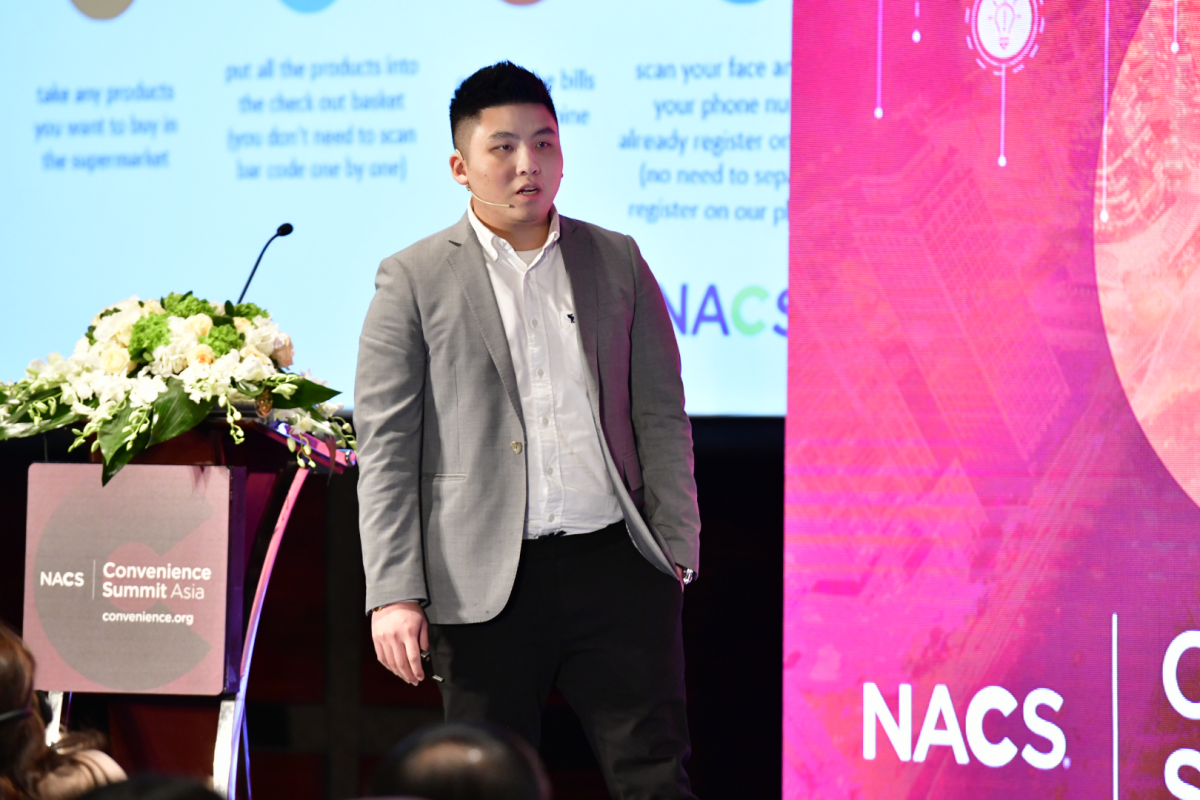 Adam Weng, Shanghai sales lead for Tesla, shared his company’s strategy and view of where electric vehicles (EVs) are headed in Asia
Adam Weng, Shanghai sales lead for Tesla, shared his company’s strategy and view of where electric vehicles (EVs) are headed in Asia
Retailer Case Studies
Delegates heard from a number of leading convenience operators in China, including Hema, which is integrating online and offline channels to great effect and is a prime example of the retail evolution that’s taking place. While 60% of Hema sales are online and growing, offline sales are increasing too. According to Hema, new retail means adopting a customer-centric approach versus a retailer-centric strategy. The operation is characterized by five key elements: unique consumer value (discovery/experience plus convenience and fresh), fully digitalized stores, a smart supply chain, AI-powered fulfillment engine and supply chain traceability.
Representatives from two Japanese retailers, Family Mart and Lawson, revealed why they are convenience leaders in China. Lawson operates 2,000 stores and wins seven million customer visits per week. Its strategy is based on a “bicycle theory” of balancing the “size” or focus of the front and rear wheels: The front is focused on store development, marketing, sourcing and PR and the rear on operations, IT systems and standardized management. The retailer differentiates in marketing and products and is experimenting with self-scanning checkout.
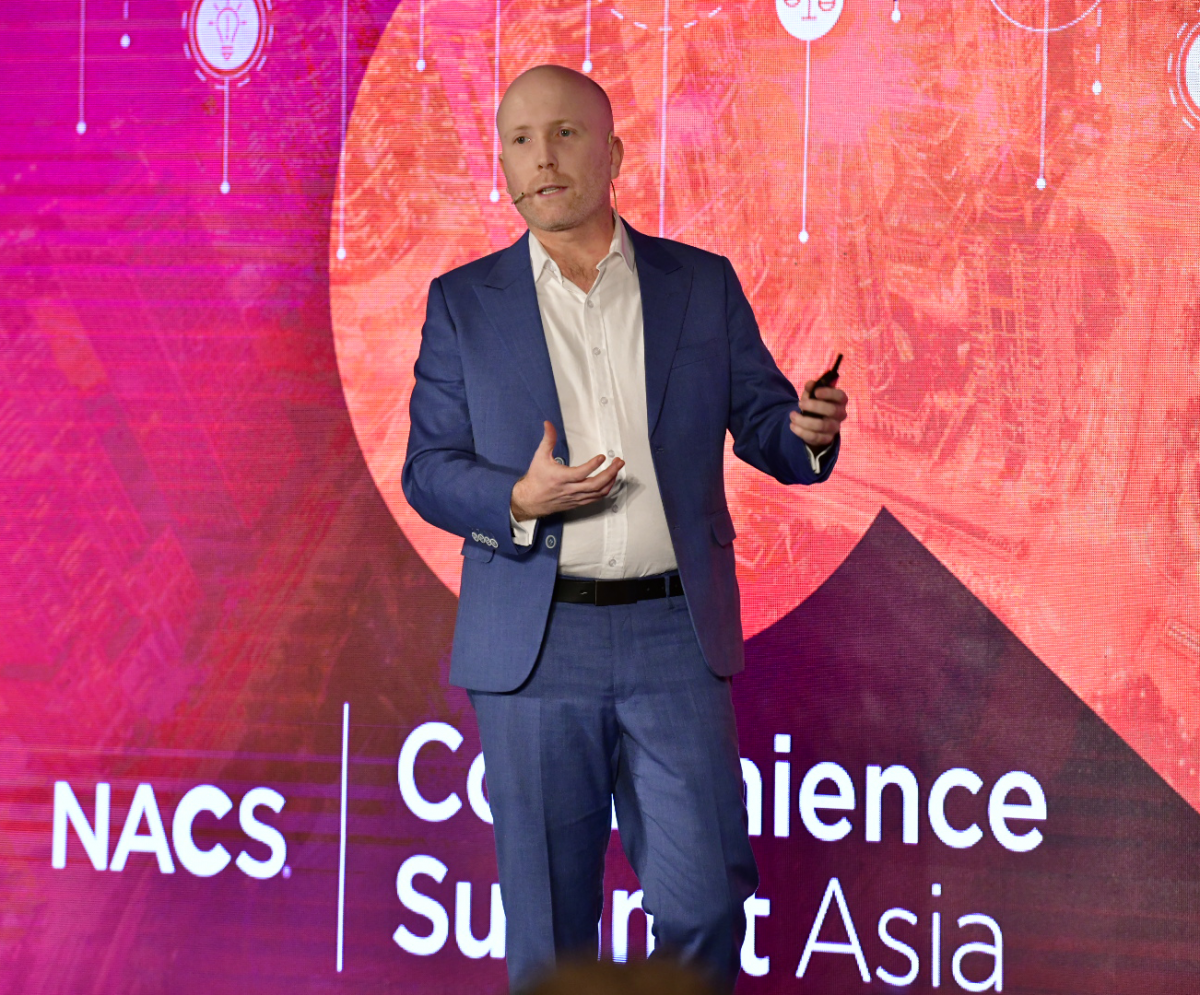 Matthew Brennan from China Channel dissected the trend to “new retail."
Matthew Brennan from China Channel dissected the trend to “new retail."
As one of the nation’s major energy companies, Sinopec competes in China’s disruptive market and how it does so was shared by company General Manager Liu Zhihua; while Lei Zhu, vice president of PetroChina, revealed how the company’s uSmile convenience store brand is performing and its future plans. PetroChina operates 21,000 sites serving 11 million customers a day and is the third-largest oil company in the world. Despite enjoying 35% annualized sales growth at uSmile, Zhu reports there are cultural barriers to foodservice growth because of a preference for at-home cooking. As a consequence, there is demand for staple cooking ingredients, and uSmile focuses on bulk sales of staples such as rice and oil. The retailer also focuses on car-care products. Data analytics are key for this major player. “Data is like oil…it lubricates retail,” said Zhu.
The general sessions of Convenience Summit Asia closed with a panel discussion debating the key conference themes and trends and an event wrap-up by Armour.
 Jose Victor Paterno (center), president and CEO of Philippine Seven Corp., won the NACS Asian Convenience Industry Leader of the Year Award. NACS President and CEO Henry Armour (left) and Kent Montgomery, VP/GM Global Customer Team at Pepsi (right), presented the award.
Jose Victor Paterno (center), president and CEO of Philippine Seven Corp., won the NACS Asian Convenience Industry Leader of the Year Award. NACS President and CEO Henry Armour (left) and Kent Montgomery, VP/GM Global Customer Team at Pepsi (right), presented the award.
And the Award Goes to...
During the NACS Convenience Summit Asia, Jose Victor Paterno, president and CEO of Philippine Seven Corp. dba 7-Eleven Convenience Store, was presented with the Asian Convenience Industry Leader of the Year Award. The award, endowed by PepsiCo, recognizes and honors the contribution of the most successful and influential convenience industry leader of 2019 in the Asian region.
Paterno is recognized for navigating Philippine Seven through the implementation of one of the most complicated supply chain networks in Asia. The company operates 13 warehouses nationwide and overcomes the country’s island geography to deliver daily to 2,600 stores across an archipelago that comprises more than 7,000 islands. His company uses that network to offer store pickup points for items ordered online through its CLiQQ Shop and Rewards Program, making the Philippines convenience chain a true “online-to-offline” retailer.
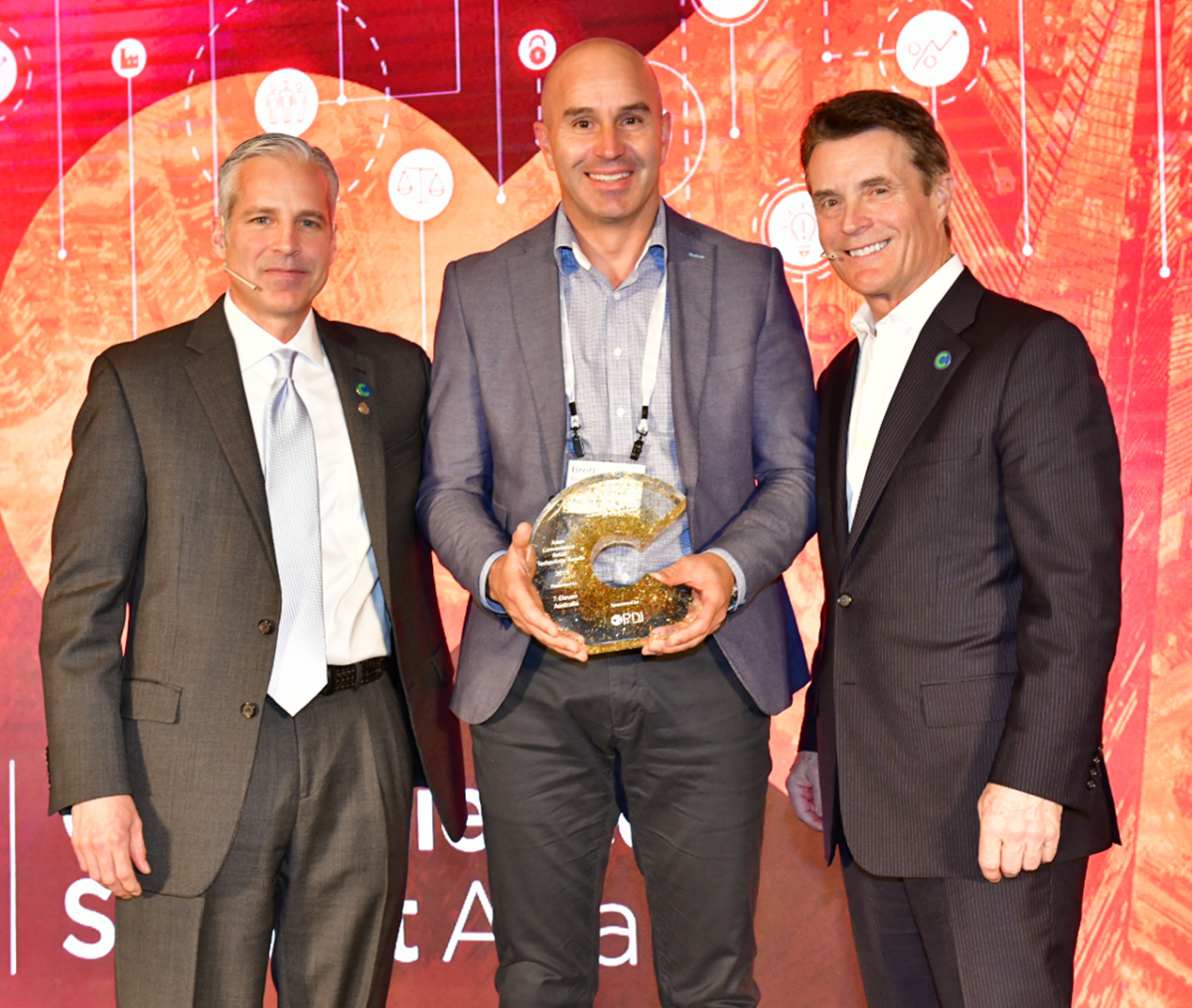 7-Eleven Australia is this year’s recipient of the inaugural NACS Asian Convenience Retail Technology Award. The award recognizes the retailer’s innovative 7-Eleven Fuel App. NACS President and CEO Henry Armour (right) and Drew Mize, SVP and general manager of PDI (left), presented the award to Brett Barclay, director, Convenience Measures Australia, who accepted the award for 7-Eleven Australia.
7-Eleven Australia is this year’s recipient of the inaugural NACS Asian Convenience Retail Technology Award. The award recognizes the retailer’s innovative 7-Eleven Fuel App. NACS President and CEO Henry Armour (right) and Drew Mize, SVP and general manager of PDI (left), presented the award to Brett Barclay, director, Convenience Measures Australia, who accepted the award for 7-Eleven Australia.
At the event, 7-Eleven Australia became this year’s recipient of the inaugural NACS Asian Convenience Retail Technology Award. The award, sponsored by PDI, recognizes the retailer’s innovative 7-Eleven Fuel App. More than 1.6 million Australians have downloaded the 7-Eleven Fuel App, which allows them to lock in the best local fuel price at one of the 520-plus 7-Eleven fuel stores throughout the country. App users also have access to exclusive and personalized deals on in-store merchandise at any of 7-Eleven’s 680 stores.
The app searches for the five nearest 7-Eleven stores within 250 kilometers of a customer’s current location. Then, a “best local price” displays the lowest price found at those stores, which consumers can then “lock in” that price and redeem petrol for that amount at any 7-Eleven store in the country within seven days. If the price decreases within that time, customers will pay the lowest price. Since launching in 2016, the app has collectively saved customers more than 10 million Australian dollars ($7 million) on fuel purchases.